
Fruit in Sailor's Accounts Menu: 1 2 3 4 5 6 7 Next>>
Fruit in Sailors Accounts During the Golden Age of Piracy, Page 1
Fruit was one of the few categories of food which were not typically available when a ship was at sea, except within the first week or two of leaving land. The one exception was a day's ration of half a pound of raisins (and one and a half pounds of flour, together used to make a savory pudding), which the navy provided as an relatively unpopular alternative to salt beef twice a week when a ship sailed below 39th parallel north. So the vast majority of instances of fruit are found in sailors book when they were on land.
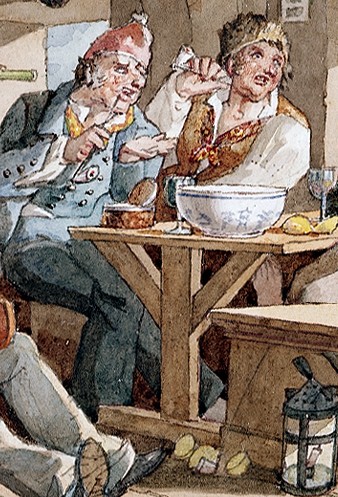
Artist: William Henry Pyne
Lemons Used in Punch, From
Sailors Carousing on Shipboard (c. 1820)
Sweet, exotic fruits might have been a popular food with sailors, except for the fact that some surgeons felt 'immoderate' use of them caused fluxes, or diarrheas. This was apparently conveyed to the men; sailor Edward Barlow explains that sailors
drinking altogether water and eating the hot country provisions... and eating many times much of their sweet luscious fruits, changing all our victuals and drink upon a sudden... if a man be not very moderate and careful, it is a thousand to one if he catch not some disease or another presently, the bloody ‘flukes’ being the rifest, which is seldome helped and killeth a lustry strong man in ten days.1
This information likely tempered some consumption of foreign fruits by sailors. On the other side of the health coin, fruit was among several things thought by some sailors and surgeons to be helpful in cases of scurvy even though this was not proven to the navy's satisfaction until decades after the the end of the golden age of piracy. Whatever the navy thought of them, citrus fruits like lemons, limes and oranges - excellent sources of the vitamin C - are among the most mentioned fruits in the sailor's accounts under study. Admittedly, while scurvy may have influenced their popularity among sailors, it is more likely that the tang of citrus provided a nice contrast to the frequently mentioned period cocktail, punch. (This may also have had something to do with the connection of fruit to diarrhea as well.)
Period sailors accounts are filled with examples of the fruit found at different ports in the various parts of the world where they traveled. In all, a total of 57 different fruits are discussed here. While most of them appear in several accounts, a handful are only mentioned in a single sailor's account. While these may have been consumed by sailors, such limited support suggests otherwise. These may have been included because the author felt they were interesting rather than good food. With this in mind, single-author fruit instances are not included in the main part of the article, but are discussed on the last page.
1 Edward Barlow, Barlow’s Journal of his Life at Sea in King’s Ships, East and West Indiamen & Other Merchantman From 1659 to 1703, p. 209
Fruit Found Which Was Found In More Than One Sailor's Account
A total of 49 fruits occur more than once in the 29 different accounts under study. These accounts come from sailors who wrote about experiences which include the golden age of piracy (1690-1725) and sometimes the period about 30 years before. The authors of these accounts come from five different categories of long-range sailors: English navy, merchants, buccaneers, privateers and pirates. A full list of the books used in this article is shown below.
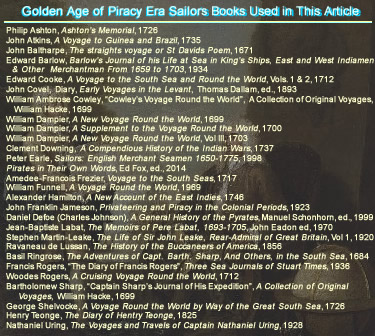
Image Artist: William Hogarth - Woodes Rogers and His Family (1729)
The number of appearances alone cannot tell the whole story, of course. For example, raisins and currants are only mentioned in 4 accounts, yet we know were eaten by many navy sailors as part of the standard diet in the Mediterranean. Their infrequency in the accounts may be in part because there are only a handful of naval accounts used and in part because it was in the alternative regular diet and didn't seem worth mentioning.
Another important factor to the frequency with which a fruit is found was the number of different locations where it grew combined with how worthwhile the locals in each place felt it was worth cultivating. Bananas and plantains were grown and intentionally planted in many warm, tropical regions including the Caribbean, South and Central America, India, China and Africa, all places where European sailors commonly stopped during the golden age of piracy. In addition to the fruit being recognized as a possible alternative to bread. The utility of banana plants and fruit made it worth cultivation and thus more prevalent in places where ships stopped which the numbers suggest. Similarly, nearly every part of a coconut tree was made use of in tropical locations and the frequency with which they appear bears this out.
Each entry for fruit mentioned in more than one sailor's account first gives a common name followed by the genus and species in parenthesis where it is known.
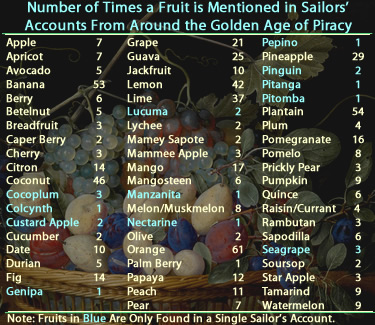
Image Artist: Jacob van Hulsdonck - Fruit in and around a basket (1620)
In some cases there are several species which may be applicable so only the genus is provided. The entry then indicates the names(s) by which the fruit is referred in the sailor's accounts, the number of times that fruit appears in the sailor's accounts under study, how many different accounts it appears in and how many different ship's journeys it appears in (some authors accounts present journeys on a variety of ships, so there is some overlap.) A chart is also included showing which types of sailors mention the fruit.
Regarding the names of fruits found in this article, many were fairly standard (albeit sometimes misspelled), but some of the more exotic and less recognized fruit is called by names given by the local inhabitants. Sometimes a fruit is simply described without providing any name at all. However, for the most part, the fruit mentioned is recognizable by its name. On occasion, seafaring writers called a fruit they didn't recognize by the name one similar in appearance. Even the usually careful Dampier at one point mentions that he found the largest limes he had ever seen while in Vietnam.1 Author John Masefield, who edited Dampier's books in the 20th century, identifies these Vietnamese limes as pomelos and citrons based on the fruit that grows there.2 Even so, some of these fruits were likely misidentified by the sailor author, the editor of his account or possibly even the author of this article. So caveat emptor.
The main body of the text includes a period description of the fruit, providing the details of the taste and preparation of the fruit found in the books of sailors, medical professionals and botanists of the period when they exist. The emphasis in this article is on the period descriptions and understanding of fruits, not the modern perspective. In the rare instances where period descriptions are lacking or incomplete, modern descriptions have been used.

Artist: Albert Anker
Hippocrates Composite Portrait

Paracelsus Aureolus Theophrastus Bombastus
von Hohenheim (1455)
Since this website concerns medicine, some information on humoral properties which are originally based on the works of Hippocrates, who identified four humoral properties present in nearly everything including foods. The four properties associated with food include hot, cold, moist and dry. According to the primary medical theory in use during this period, the humoral properties of food, combined with a patient's own humoral makeup (the four properties of which were blood, phlegm, yellow and black bile), affected their health.
One botanical author - Louis Lémery - uses the three Paracelsian principles instead of humors. These principles include salt, composing the solid state of a body; sulfur, responsible for an inflammable or fatty state; and mercury, engendering a smoky (vaporous) or fluid state.3 The translation of Lémery's work uses the terms salt, oil and phlegm, with phlegm apparently corresponding to mercury.
In addition, any specific comments of interest about the medicinal or healing properties of a fruit are given. While these sometimes tie directly into the humoral theory (and, more often, indirectly in an unstated manner), surgeons would typically have been a little less interested into these theoretical connections than physicians, preferring to see how a fruit would help or hinder a particular disease or aspect of a patient's health.
For ease of reference, all the fruits included in this section can be directly accessed in the list below. Clicking on the fruit will take you directly to the information for that fruit.
| Fruit Found in More Than One Sailor's Account During the Golden Age of Piracy | ||||
|---|---|---|---|---|
| Apple | Apricot | Avocado | Banana | Berry |
| Betelnut | Bread Fruit | Caper Berry | Cherry | Citron |
| Coconut | Cucumber | Date | Durian | Fig |
| Grape | Guava | Jackfruit | Lemon | Lime |
| Lychee | Mamey Sapote | Mammee Apple | Mango | Mangosteen |
| Melon/Muskmelon | Olive | Orange | Papaya | Peach |
| Pear | Pineapple | Plantain | Plum | Pomegranate |
| Pomelo | Prickly Pear | Pumpkin | Quince | Raisin/Currant |
| Rambutan | Sapodilla | Soursop | Star Apple | Tamarind |
| Watermelon |
1 William Dampier, "Part 1", A Supplement to the Voyage Round the World, 1700, p. 24; 2 See Footnote 2 William Dampier, Dampier's Voyages, Volume 1, John Masefield ed., 1906, p. 576; 3 "From Alchemy to Chemistry: Five Hundred Years of Rare and Interesting Books", illinois.edu website, gathered 7/28/22;
Fruit Found In A Single Sailor's Account
As noted in the previous section, there are several fruits which appear in only one sailor's account, making it more difficult to justify their being a regular part of a seaman's diet.
In all 13 such fruits are included here. 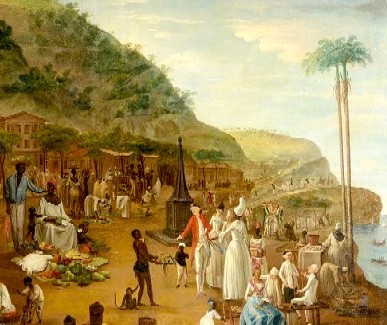
Artist: Le Masurier - Market at St. Pierre, Martinique (18th c.)
More than half of these are found in the writings of the ever-curious William Dampier, who took great pains to describe the unusual things he found while making his various circumnavigations. For many of the fruits he mentioned he discusses their flavor, which suggests he at least tasted them. For single When Dampier says his information about a fruit is second-hand and he is the only one to mention it, it is excluded from this list. In addition, when fruits he talks about could not be identified, they are likewise left out.
A few of the single instance fruits come from the writings of naval surgeon John Atkins. Like Dampier, Atkins often describes the unusual things he encountered, sometimes describing them without mentioning whether they were eaten by sailors or not. Similarly, French mathematician and possible spy Amedee-Francois Frezier describes the interesting things he found while visiting the Spanish outposts in South America, including some fruit. Such fruits are included here.
As with the previous entries, a common name is first provided for each fruit followed
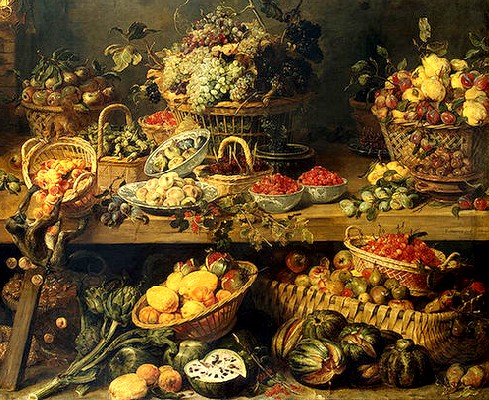
Artist: Jan Wildens and Frans Snyders - Fruit Stall (1618-21)
by the genus and species in parenthesis where it is known. Where there are several species which may be applicable, only the genus is provided. This is followed by the name by which the sailor's account refers to the fruit. Since there is only one account from which to draw information, the rest of the format of the single author fruits is slightly different. Only the number of times the author mentions the fruit and how many different journeys he undertook where he saw such fruit are included, since the number of sailor accounts is not relevant. The author and ship type are included along with the locations where the fruit was spotted. Descriptions, uses as food and medicinal information are culled from period sources as much as possible and from modern sources where necessary.
Keep in mind that when one sailor mentions tasting these exotic fruits, it is very likely that they were eaten by some of the other adventurous European sailors in the seventeenth and eighteenth centuries, even if they didn't record this fact. The fact that there are only 29 accounts when large ships had hundreds of sailors suggests this. Each of the fruits mentioned in a single account can be accessed by clicking on the link in the chart below.
| Fruit Found in A Single Sailor's Account During the Golden Age of Piracy | ||||
|---|---|---|---|---|
| Cocoplum | Colocynth | Custard Apple | Genipa | Lucuma |
| Manzanita | Nectarine | Palm Berry | Pepino | Pinguin |
| Pitanga | Pitomba | Seagrape |

